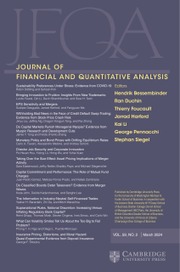No CrossRef data available.
Article contents
Poison Pills in the Shadow of the Law
Published online by Cambridge University Press: 07 April 2025
Abstract
Poison pills are among the most powerful antitakeover provisions, but studying their economic impact is challenging because of the obvious endogeneity concerns. We address the problem by studying U.S. states’ staggered adoption of poison pill laws (PPLs), which strengthen the right to adopt a pill (i.e., the shadow pill) and increase the validity of visible pills. We document that PPLs make visible pill policy aligned with economic incentives, increasing pill adoption among firms with a high likelihood of takeover, but decreasing it among firms with low takeover likelihood. We also document that PPLs positively impact firm value, especially for innovative firms with more intangible assets.
- Type
- Research Article
- Information
- Creative Commons
- This is an Open Access article, distributed under the terms of the Creative Commons Attribution licence (http://creativecommons.org/licenses/by/4.0), which permits unrestricted re-use, distribution and reproduction, provided the original article is properly cited.
- Copyright
- © The Author(s), 2025. Published by Cambridge University Press on behalf of the Michael G. Foster School of Business, University of Washington


